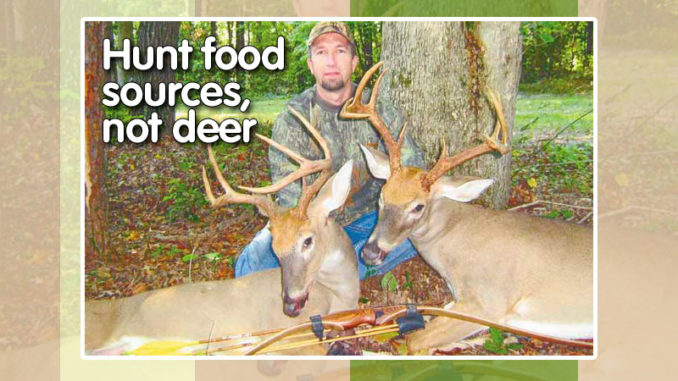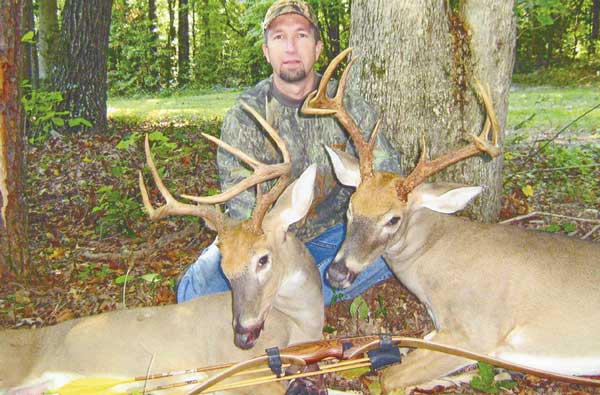
Hunters have known since the beginning of time the best places to find wild game are near food sources.
From the beginning of bow season in early September in North Carolina until the last day of gun season January 1, hunting food sources is the tactic needed to find wildlife, deer in particular, on a regular basis.
The situation may vary a little during the pre-rut season, which begins about mid-October, through the peak of the whitetail rut that extends through the month of November.
Find the preferred and most available food source, and you’ll see deer. Even during the rut, does come to food sources and bucks follow does anywhere, so you may see old Mossy Horns at a food source area.
In recent years, many companies offered a variety of seeds to plant food plots for whitetails and other wildlife. Several varieties of clovers, peas, grasses, and greens are available at local sporting goods and big box discount stores.
Longtime bowhunter, David Hendrix, who is the archery pro at Gander Mountain in Greensboro, uses corn only during the early season and doesn’t use a feeder.
He scatters 15 to 20 pounds of corn in a semi-circle about 15 yards from his stand and uses a trail camera to monitor visits to his sites.
“Bucks usually find the corn first,” he said, “and that’s when I hunts the stand.”
If he starts seeing too many does in his trail-cam photos, he stops baiting and hunting that location and moves to another place. He says the does run the bucks away, and bucks won’t come to a stand once does find it.
Hendrix hunts the early season with a longbow. so he places the corn only 15 yards from his tree stand instead of 20 yards. Five yards makes a big difference when hunting with a traditional bow.
During 2007, he took two nice bucks from the same stand, the same day, about 30 minutes apart with his longbow.
Some seeds require a lot of plowing and tilling to get the best results, requiring at least a small garden tractor with attachments to do the job. These products usually contain a variety of seed like forage clovers, rye grasses, rape brassica and other high-protein, quick-growing seeds.

Growers will have to clear down to bare ground, cover the seed with soil and add fertilizer and lime as directed on the packaging of the product. Food plots should be located in an area that will get at least half day of sunlight.
Other wildlife plantings are called “No Till” or “Throw and Grow” seeds and can be planted with relative ease, using hand tools and a little elbow grease.
Using heavier equipment obviously should produce the best results and reduce the effort and time to get the job done.
The time to plant food plots can varym depending upon personal preference and time available to work. One could begin after the spring thaw and continue through the summer — or (more likely) begin planting at mid-August and continue through the fall where adequate moisture (precipitation) is available (usually the end of September in the piedmont).
To get an idea of how well a food plot is growing, construct a square or round, fenced area about 4 feet in diameter and at least 4-feet high at the center of a food plot. then and anchor it so deer can’t push it over.
Such a spot allows seed to grow undisturbed within its area. By observing the growt rate inside the fenced area, a hunter can determine how well the entire plot should grow if deer weren’t browsing. It’s simple to get an idea of how much feeding pressure the plot is receiving from deer.
However, early in the season, particularly early September, many woods and uncultivated fields feature plenty of favorite deer foodstuffs (not including farm crops such as soybeans, corn and other crops, although these sources shouldn’t be ignored).
Early in the deer season, in September, hunters will find deer frequenting areas with wild grapes and muscadines. Deer don’t remain there for long, a couple weeks at most.
Deer, other wildlife and humans will dine on these sweet delicacies. When they’re ripe and falling from the vines that often grow high in woodland trees, hunters often can smell their aroma simply by walking through a woodlot.
After discovering a good stand of muscadine vines, hunters should make a note of their location for reference in future years.
Persimmons are another prized delicacy by whitetails. They begin falling to the ground around the first frost, usually in mid-October. A wise hunter who finds a wild persimmon tree that is bearing fruit should set a stand nearby.
Acorns are another natural food most hunters have observed have magnetic properties for deer, especially white oak acorns.
Deer also eat smaller nuts (pin oaks and red oak acorns) and other varieties if preferred varieties aren’t readily available.
So locate white oak trees at hunting properties and make a note of their locations for future reference. Check them annually to see if they’re producing acorns. Some years they’ll produce and some years they won’t.
As soon as acorns start falling normally, or when squirrels cut them from the branches, that’s the place to hang a stand (usually from early October into mid November).
Honeysuckle is good forage for deer and is available year round, even after frost and freezing weather arrives. Honeysuckle leaves are high in protein and a favorite deer browse.
When oaks don’t produce acorns, or other natural or domestic foods, find a secluded honeysuckle thicket. Hunters can help honeysuckle growth by broadcasting a bag of 10-10-10 fertilizer over the entire thicket where it’s growing from spring through the summer and fall seasons.
I hunted a remote honeysuckle thicket in Caswell County for years and took a number of deer as they stopped to browse on the luscious green leaves. Every year, I spread a bag of fertilizer at this honeysuckle thicket to boost its growth.
Green briars are another natural source of high-protein deer browse. Often no leaves grow on the green vines up to 6- or 7-feet high, not because leaves didn’t develop and grow at lower levels but because deer usually eat them as fast as they bud and begin to grow. They’ll eat greenbriar leaves as high as they can reach by standing on their hind legs.
Don’t forget fruit trees, such as apples and pears, and flowers such as hostas and sunflowers. Many times, they grow where old homes have long since fallen down or been demolished.
Deer love apples and pears, I think even better than white oak acorns and other foods.
If there’s no tree big enough to hold a stand near a fruit tree, gather up the fruit and scatter it in a circle about 20 yards from a tree suitable for a stand.
Acorns work as well. Rake them into a pile, fill a bag with them and carry them to a preferred stand site and scatter them 20 yards from the stand.
Deer also will visit your backyard gardens and flower beds and wreak havoc on hosta, sunflowers and roses.
Lastly, it bears mentioning that it’s legal to use bait in North Carolina for hunting deer at private lands (but not at game lands).
Motorized feeders are efficient but difficult to move and relocate. They’re also subject to being stolen by trespassers who have no regard or respect for property rights of land-owners or leased lands. And feeders aren’t cheap.
The best idea is to use sections of 4-inch diameter PVC pipe with a cap on top and a 2- to 4-inch reducer at the bottom. I cut a slot out of the 2-inch reducer to allow shelled corn to flow out after I’ve painted the pipe black to make it less visible and strapped it to a tree with nylon tie straps.
I put a short board on the ground under the bottom to help control the flow of corn. I get about 30 pounds of corn into a 5-foot-long section. Depending on the frequency of deer visits, a full feeder will last anywhere from one to three weeks before needing a refill.
Early-season bowhunting can be productive if a hunter locates the available food sources and hunts them regularly.
Deer are predictable this time of the year, remaining in summer feeding patterns.
Unless something spooks whitetails, they’ll follow the same movement patterns on a daily regular schedule.



Be the first to comment